Great Design Plant: Parkinsonia Flor Paints the Desert Green and Yellow
http://decor-ideas.org 10/07/2014 22:35 Decor Ideas
Perhaps the most iconic tree of the desert Southwest is the palo verde (Parkinsonia florida), with its characteristic green trunk and branches. This native desert tree comes with a Spanish name that literally translates to “green stick,” referring to its green trunk. But its decorative trunk is just the beginning, as yellow flowers completely cover its canopy in spring.
Native to Southwestern deserts, blue palo verde is tough and can handle what nature brings its way, whether it’s intense reflected heat or drought, or the relatively cold Southwestern winters in zones 7 and up. In times of drought, it simply drops its leaves, and its green trunk and branches carry on with photosynthesis.
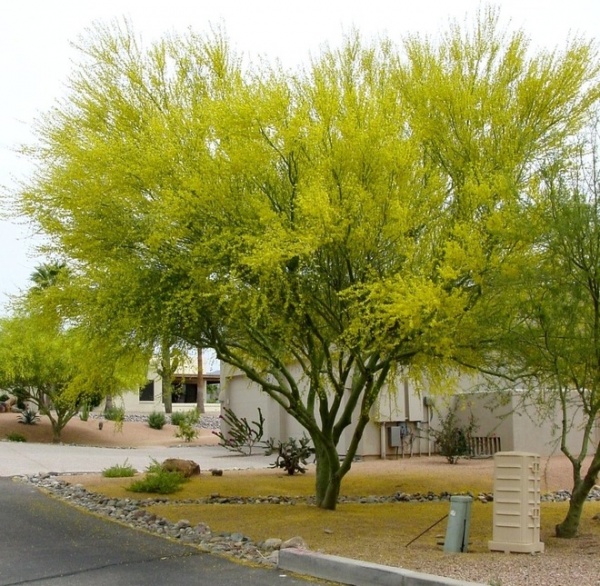
Botanical name: Parkinsonia florida (formerly Cercidium floridum)
Common name: Blue palo verde
Origin: Native to the Sonoran Desert regions of southeastern California, southern Arizona and northern Mexico; often found growing along washes
Where it will grow: Hardy to 15 degrees Fahrenheit (USDA zone 7; find your zone)
Water requirement: Drought tolerant once established, but looks best when watered deeply once or twice a month in summer
Light requirement: Full and reflected sun
Mature size: 15 to 30 feet tall and wide
Benefits and tolerances: Drought tolerant; provides filtered shade
Seasonal interest: Lightly fragrant, yellow flowers in late spring
When to plant: Fall or spring
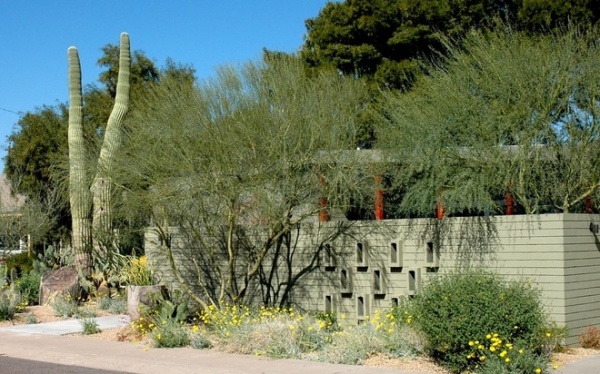
Distinguishing traits. Some people claim that the beauty of blue palo verde comes from its distinctive green trunk and wispy branches, while others would argue that its yellow flowers in spring are its best feature. Whatever side you fall on, there is general agreement that this desert native is a beautiful asset to the drought-tolerant landscape.
The natural form of blue palo verde resembles a large shrub, but in a landscape setting, you will most often find it pruned into a tree form, so that its attractive branch architecture (branch arrangement) can be appreciated.
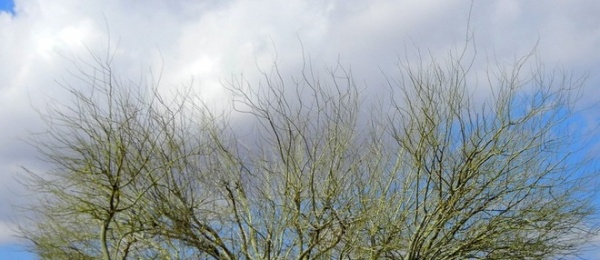
The leaves are made up of five to 10 tiny leaflets, which cover the green branches in spring through fall when enough water is present. Blue palo verde’s branches do have small thorns. During winter the leaves can sometimes drop due to a lack of water.
This tree is drought deciduous, like other palo verde trees, which means that during times of drought, the leaves are shed to save the water that otherwise would be lost through the leaves. New leaves will reappear once the tree receives water through rainfall or from other sources.
While established blue palo verde trees can usually survive on rainfall alone, they look best when watered once or twice a month during the summer, which mimics their native growing environment next to desert washes.
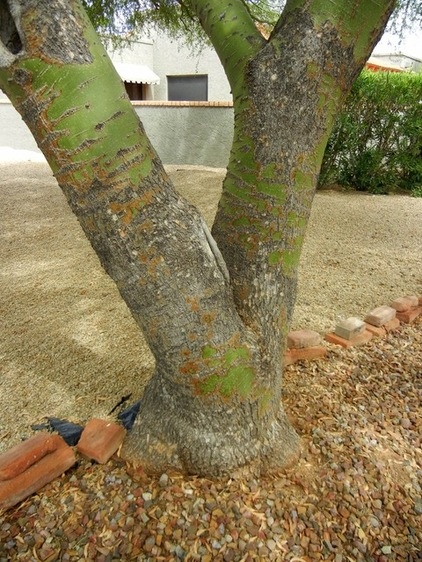
Palo verde continues photosynthesizing through its trunk and branches even when it loses its leaves, enabling the tree to continue to survive despite drought conditions. As blue palo verde trees age, their bark begins to turn gray in patches that gradually cover the entire main-part trunk. Younger branches will remain green.
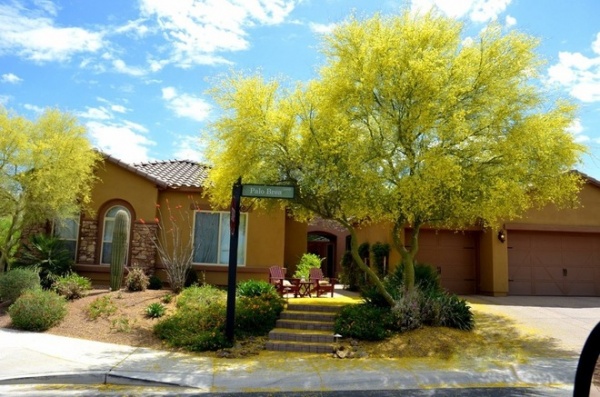
Warm spring temperatures bring the arrival of lightly fragrant yellow flowers. Many people look forward to the annual flower show, but those who have planted a blue palo verde tree near a swimming pool may be frustrated when the yellow petals inevitably find their way into the water. Fallen flowers are easily cleaned up from sidewalks.
Once flowering has ended, 2- to 3-inch tan, papery seedpods are produced.
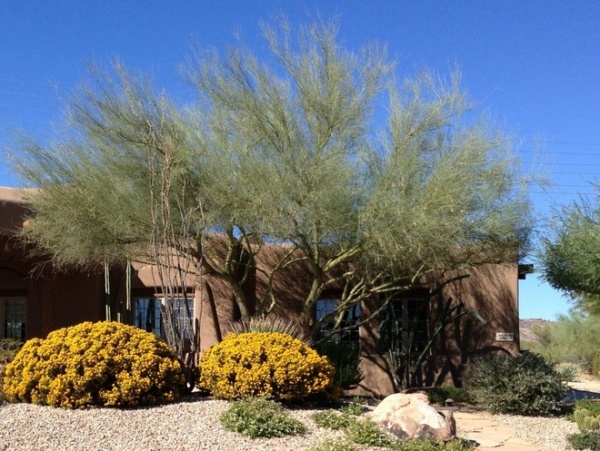
How to use it. Blue palo verde can be used as a single accent tree in the landscape with an arrangement of decorative boulders, lower-growing shrubs, ground covers and succulents. These green trees can also be used to flank a pathway in a more formal setting, where their canopies provide filtered shade to those walking underneath. Although they are available as single-trunk trees in the nursery, select one that has been trained into a multitrunk shape, which is more attractive and more closely mirrors its natural form.
To make the most of the yellow flowers in spring, plant red- or purple-flowering plants like Baja fairy duster (Calliandra californica), blue bells (Eremophila hygrophana ‘Blue Bells’), desert ruellia (Ruellia peninsularis), firecracker penstemon (Penstemon eatonii) or verbena (Glandularia spp) for a great color contrast. Blue palo verde also looks great next to the unusually shaped ocotillo (Fouquieria splendens), whose vermillion flowers also contrast palo verde’s beautifully.
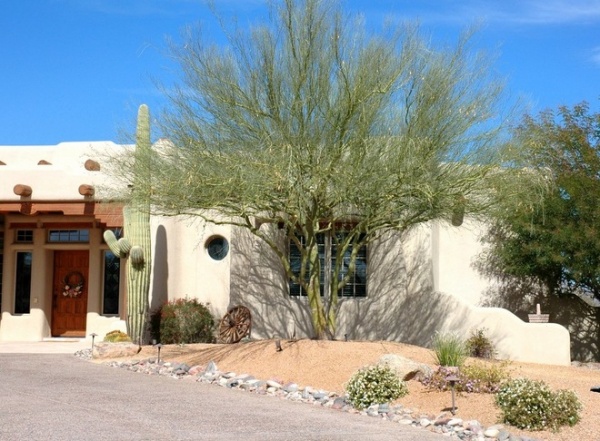
Planting notes. Plant it in full sun and well-drained soil. For best results do not plant it in or alongside a lawn, where fertilizer and excess water can stimulate new growth in fall and winter that is more susceptible to frost damage. No supplemental fertilizer is needed, since blue palo verde is adapted to well-drained native desert soils.
Blue palo verde trees can be bothered by spider mites that can cause the growth of small clusters of branches, called witches’ broom, but they are easily pruned out.
More:
How to Spot a Drought-Tolerant Plant
Browse plants native to more regions of the U.S.
Related Articles Recommended












